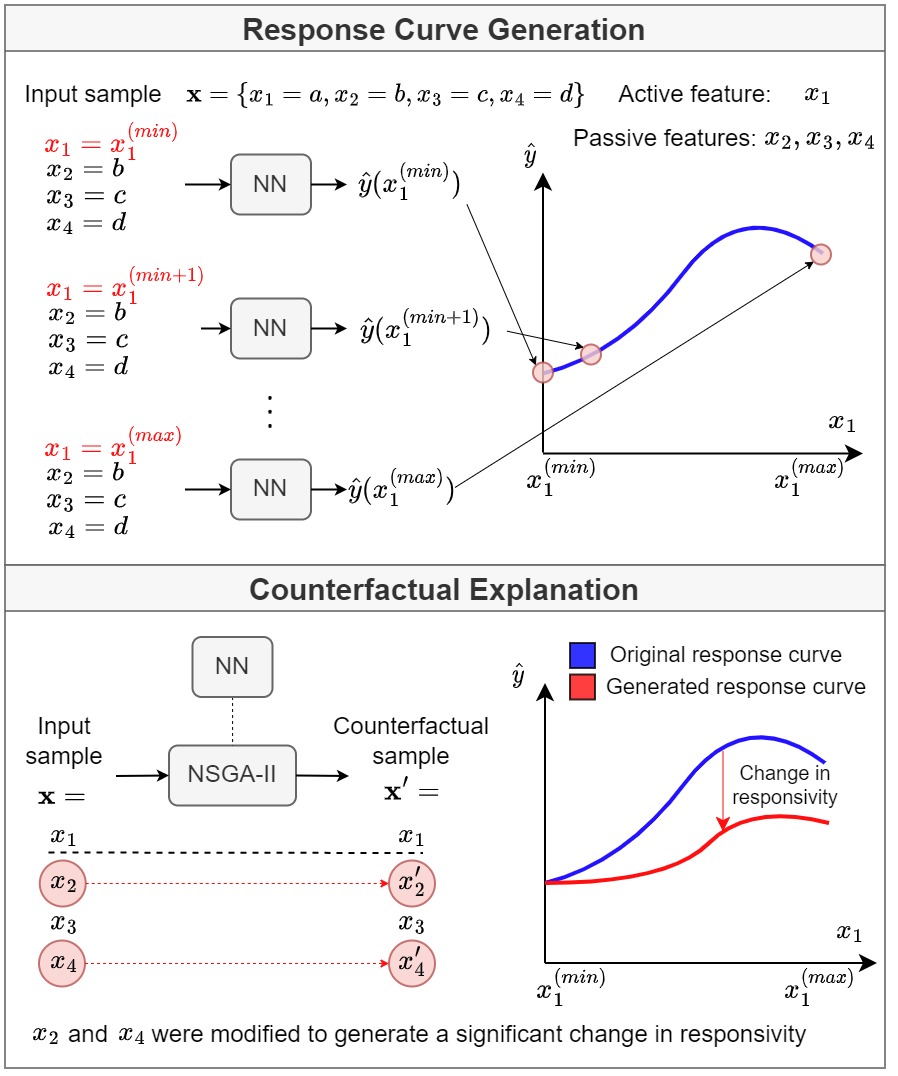Response curves exhibit the magnitude of the response of a sensitive system to a varying stimulus. However, response of such systems may be sensitive to multiple stimuli (i.e., input features) that are not necessarily independent. As a consequence, the shape of response curves generated for a selected input feature (referred to as “active feature”) might depend on the values of the other input features (referred to as “passive features”). In this work we consider the case of systems whose response is approximated using regression neural networks. We propose to use counterfactual explanations (CFEs) for the identification of the features with the highest relevance on the shape of response curves generated by neural network black boxes. CFEs are generated by a genetic algorithm-based approach that solves a multi-objective optimization problem. In particular, given a response curve generated for an active feature, a CFE finds the minimum combination of passive features that need to be modified to alter the shape of the response curve. We tested our method on a synthetic dataset with 1-D inputs and two crop yield prediction datasets with 2-D inputs. The relevance ranking of features and feature combinations obtained on the synthetic dataset coincided with the analysis of the equation that was used to generate the problem. Results obtained on the yield prediction datasets revealed that the impact on fertilizer responsivity of passive features depends on the terrain characteristics of each field.
Please read our IJCNN paper for more information.
This repository contains the following scripts:
-
FeatureResponsivity.py: Contains the FeatureResponsivity class. The main method of the class isimpactwhose parameters are:*`s`: Index of the feature whose responsivity w.r.t response variable will be assessed. *`epsi`: List of tolerance errors that will be tested. *`replace`: If True, overwrite existing results. *NOTE: This implementation assumes that the models are already trained using Trainer.py and 10x1 CVThe class can be instantiated and executed as follows:
name = 'Synth' fresp = FeatureResponsivity(dataset=name) fresp.impact(s=0, epsi=[0.4, 0.6, 0.8], replace=True) -
Trainer.py: Class used for training the NNs using 10x1 cross-validation. -
MOO.py: Implements the multi-objective optimization (MOO) framework and defines the objective functions. -
DataLoader.py: Load and pre-process the datasets. -
utils.py: Additional methods used to transform the data and calculate the metrics.
Use this Bibtex to cite this repository
@INPROCEEDINGS{Morales:Counterfactual,
AUTHOR="Giorgio Morales and John W. Sheppard",
TITLE="Counterfactual Explanations of Neural {Network-Generated} Response Curves",
BOOKTITLE="2023 International Joint Conference on Neural Networks (IJCNN) (IJCNN 2023)",
ADDRESS="Queensland, Australia",
DAYS="17",
MONTH=jun,
YEAR=2023,
}

